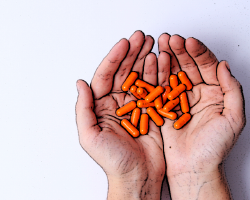Are We Replacing an Opioid Epidemic with a Stimulant Epidemic?

As long as I have been working in the field of addiction recovery, the entire industry from the top to the bottom has been playing a massive game of whack-a-mole. That’s the carnival game where a mechanical animal head pokes out of a panel with multiple holes in it. As soon as you whack one with a large mallet, another one appears.
In the same way, as soon as we make inroads on one type of addiction- or death-causing type of drug abuse, another problem shows up to take its place. And now in particular, as national efforts have been mounted to push back on opioid abuse and addiction, the use of stimulants seems to be rising to take its place.
Let’s look at some answers to the questions about stimulant addiction.
Which Stimulants Are Most Frequently Abused?
Both prescription stimulants and illicitly manufactured stimulants are being abused.
Examples of prescription stimulants:
- Dextroamphetamine (brand name Dexedrine)
- A mixture of dextroamphetamine and amphetamine (Adderall)
- Methylphenidate (Ritalin, Concerta)
Examples of illicit stimulants:
- Cocaine
- Crack cocaine
- Methamphetamine
- MDMA/Molly
- Synthetic cathonines/mephedrone/methylone
- Khat
What are the Common Short-Term Effects of Stimulants?

- Increased blood pressure
- Increased body temperature
- Faster breathing
- Constricted blood flow
- Increased alertness
- Loss of appetite
- Insomnia
- Euphoria
What Long-Term Effects Do Stimulants Create?
- Addiction
- Paranoia
- Confusion
- Anxiety
- Violent behavior
- Psychosis
- Brain damage
- Increased risk of stroke
- Increased risk of Parkinson’s disease
- Increased risk of heart attack
- Severe tooth decay
- Severe weight loss
Why Are We Seeing an Upsurge in Stimulant Use?
According to the National Institute on Drug Abuse, the patterns of drug abuse had shifted by 2018. As the powerful opioid fentanyl began to be found in more heroin supplies or as a heroin substitute across the country, some drug users began to switch to stimulant abuse. It is extremely easy to overdose on fentanyl, and, in fact, overdose deaths from this type of synthetic opioid were skyrocketing at that time. Stimulants were perceived as a safer drug to abuse and this might have been true for a while. But before long, fentanyl began to be found in supplies of methamphetamine and cocaine.
An increase occurred in the number of people mixing opioids and stimulants in an attempt to achieve a certain effect they considered desirable. For example, taking a stimulant along with an opioid enables a person to avoid the dopiness that accompanies opioid abuse.
As we as a country fight back against opioid abuse and look for ways to treat this problem, we may miss the mark if we fail to fight the root causes of drug abuse and addiction. If we whack down the opioid mole, there are plenty of other moles ready to poke their heads up and too many people are susceptible to addiction. Also too many criminal elements are ready to exploit the weak and vulnerable and turn them into steady customers—at least, as long as they can stay alive.

by USA police, 1988.
How Did We Get to This Point?
Many paths have led to this point. Coca leaves, the source of cocaine, have been used as a mild stimulant among South American people for thousands of years. In the 1980s, there was a huge surge in the cocaine supply and use in America. Much of this drug was turned into crack cocaine which was astonishingly addictive and rapidly resulted in an increase in crime.
While cocaine supplies and use have fluctuated over the years, both have been increasing in the last few years. By 2019, more than 16,000 people had died in cocaine-involved overdoses.
Amphetamines and methamphetamine have long been used medically to treat asthma, obesity and narcolepsy, with use and abuse increasing in the 1960s. They are still used for obesity and narcolepsy treatment, plus treatment of those who have trouble focusing on tasks.
In the 1980s, illicitly manufactured forms of this drug became broadly available and the number of addictions began to rise. Many efforts have been made to reduce the illicit manufacture of these drugs domestically. As of 2016, chemicals sourced in China began to make their way into Mexico in volume. Mexican criminal organizations converted these chemicals into methamphetamine and used established trafficking patterns to move the drugs into the U.S.
The use of prescription forms of these drugs began to increase dramatically between 2000 and 2016. While the appropriateness of these prescriptions can be argued, what is nonetheless true is that an increasing number of youth were exposed to the effects of stimulants.
What Are the Trends in Stimulant Abuse and Addiction?
According to the Centers for Disease Control and Prevention, cocaine-involved overdose deaths decreased in the years leading up to 2012 but then began to increase. By 2017, they were up 34%.
The total number of people dying from psychostimulant overdoses (including both prescription and illicit stimulants) increased 37% in 2017 from the previous year.
In 2019, two million Americans aged 12 or older reported that they had used methamphetamine in the past year. This number was up from an estimated 1.6 million Americans using this drug in the years between 2015 and 2018. Keep in mind that self-reported survey responses usually underreport the actual number of people using any particular drug.
Is This Problem Limited to the United States?
No, not at all. According to the World Drug Report from the United Nations Office on Drugs and Crime, it is a worldwide problem. In Africa, the primary stimulants abused are cocaine and methamphetamine. In the Middle East, it’s captagon. In Eastern Europe, it’s cocaine. In Southwest Asia, it’s methamphetamine. Every area of the globe struggles with this problem.
How Can Stimulant Addiction Be Treated?
Currently there is no medication-assisted treatment for stimulant addiction as there is for opioid addiction. Efforts are being made to develop medications for this purpose and an attempt to develop a “vaccine” that would prevent a person from reacting to cocaine.
However, many people manage to overcome addiction to stimulants without needing either vaccines or medications. The initial period of withdrawal from stimulants often requires intensive support and supervision because the cravings for more stimulants can be very strong.
The National Institute on Drug Abuse notes that “Research indicates that most addicted individuals need at least 3 months in treatment to significantly reduce or stop their drug use and that the best outcomes occur with longer durations of treatment.” Given the physical, mental and lifestyle changes that occur after long-term use of stimulants, a longer stay in a rehabilitation facility is advised.
What is the Solution to America’s Problem of Drug Abuse and Addiction?

The solution has always required three fronts of action:
- Prevention: The younger that youth can be educated on the harm done by drugs the better. Preventative classes must be chosen that have been proven to achieve a beneficial effect in terms of reduced drug use by those who have received the classes. These preventative efforts must continue throughout a child’s education and be supported with anti-drug messages at home and in the community.
- Interdiction: Drugs must still be detected and destroyed in our cities and on our borders. The Drug Enforcement Administration reported the seizure of 3,138 kilograms of fentanyl in 2019. Because the fatal dose of fentanyl is three milligrams (for a person new to opioids), that’s enough fentanyl to kill one billion people. These drugs must be taken off our streets whenever possible.
- Rehabilitation: Recovery services must be available for those who have become addicted. If they only receive treatment that replaces the addictive substances they were taking with others, they may not learn how to rely on their own life skills as they live fully drug-free. It is never easy to rebuild the life skills that were lost and to recover one’s own sober outlook on life. All the same, there is a significant benefit to recovering the ability to live without reliance on addictive substances of any kind.
Sources:
- https://www.drugabuse.gov/publications/drugfacts/prescription-stimulants
- https://www.drugabuse.gov/drug-topics/cocaine
- https://www.drugabuse.gov/publications/research-reports/methamphetamine/how-methamphetamine-different-other-stimulants-such-cocaine
- https://www.drugabuse.gov/drug-topics/trends-statistics/overdose-death-rates
- https://www.drugabuse.gov/about-nida/noras-blog/2020/11/rising-stimulant-deaths-show-we-face-more-than-just-opioid-crisis
- https://www.drugabuse.gov/drug-topics/commonly-used-drugs-charts
- https://www.narconon.org/drug-abuse/signs-symptoms-bath-salts.html
- https://www.drugabuse.gov/drug-topics/commonly-used-drugs-charts
- https://www.drugabuse.gov/drug-topics/commonly-used-drugs-charts#khat
- https://www.drugabuse.gov/publications/research-reports/methamphetamine/what-are-long-term-effects-methamphetamine-misuse
- https://www.sciencedaily.com/releases/2008/06/080604091829.htm
- https://www.npr.org/2013/07/27/206148964/how-americans-said-no-to-cocaine-after-years-long-addiction
- https://www.history.com/topics/crime/history-of-meth
- https://www.ncbi.nlm.nih.gov/pmc/articles/PMC6261411
- https://www.voanews.com/a/china-major-source-crystal-meth-shipped-into-united-states/3426604.html
- https://www.cdc.gov/drugoverdose/deaths/other-drugs.html
- https://www.narconon.org/drug-abuse/signs-symptoms-heroin-use.html
- https://wdr.unodc.org/wdr2019/prelaunch/WDR19_Booklet_4_STIMULANTS.pdf
- https://www.narconon.org/drug-information/methamphetamine/
- https://www.asam.org/Quality-Science/publications/magazine/read/article/
2014/10/15/cocaine-vaccine-research-review - https://www.ncbi.nlm.nih.gov/pmc/articles/PMC7138250/
- https://www.drugabuse.gov/publications/principles-drug-addiction-treatment-research-based-guide-third-edition/principles-effective-treatment
- https://www.dea.gov/sites/default/files/2021-02/DIR-008-21%202020%20National
%20Drug%20Threat%20Assessment_WEB.pdf


 ®
®